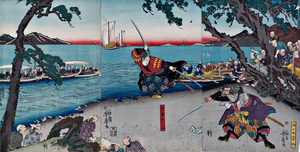Sasaki Kojirō
Sasaki Kojirō ( Japanese 佐 々 木 小 次郎 ; * 1586 (?); † April 13, 1612 ) was one of the most famous samurai in Japan .
origin
Sasaki Kojiro's origins are largely unknown, it is only assumed that he was instructed in the Chūjō-ryu fighting style by Kanemaki Jisai . He later founded his own sword fighting school called Ganryu. He was famous for his fighting technique of Tsubame gaeshi ( 燕返し , dt. Swallow counter called), also dovetail counterattack. The technique was influenced by the movements of a swallowtail in combat. As a weapon he used a nodachi , a very long two-handed sword in his duels .
Duel with Miyamoto Musashi
Kojirō's fame is largely based on his duel with Miyamoto Musashi in 1612. It took place on the morning of April 13th, and is described in books and documentaries as follows:
The duel had been arranged at 8 a.m. on the small island of Funajima. Kojiro showed up on time, but Musashi wasn't there yet. While Kojiro waited, the duel for Musashi had already begun. He knew that his late appearance would throw Kojiro off his feet. Since Kojiro with his nodachi , which is longer than any katana , had the range advantage on his side, Musashi designed a wooden sword that was a bit longer than a nodachi. He carved it out of the spare rudder of the boat that took him to the duel. About two hours late, Musashi arrived, wooden sword instead of katana in hand. Kojiro's pent-up anger discharged, he yelled at Musashi: "You are late. Were you too cowardly?" In the next moment he tore his nodachi out of the scabbard and threw it into the sea, whereupon Musashi replied with a smile: "You have already lost! Or would the winner throw away his scabbard?". Further upset by Musashi's provocation, Kojiro struck. He brushed the knot of Musashi's Hachimaki cloth and in the next moment was knocked down by his wooden sword with one blow on the skull. Kojiro was lying on the floor while Musashi was standing next to him in a fighting stance. From a lying position, Kojiro raised his sword and wounded Musashi on the thigh before he was hit in the chest by another blow of the wooden sword and died as a result.
It should have been Musashi's last duel. The wooden sword he designed was unique at the time and later became known as Suburitō (wooden sword, which is longer and heavier than a conventional bokken ). The island of Funajima was henceforth called Ganryujima out of respect for Kojiro.
Sasaki Kojiro in culture
Like most of the well-known samurai of his era, Sasaki Kojiro was depicted in several places:
- In the novel Musashi by Eiji Yoshikawa he plays a central role. His life is described in a parallel storyline.
- In various film adaptations of his story or that of Miyamoto Musashi. For example in Zoku Miyamoto Musashi: Ichijōji no kettō ( Samurai 2: Duel at Ichijoji Temple ; 1955; Director / Screenplay: Hiroshi Inagaki).
- In the manga Vagabond he plays a central role alongside Musashi and is shown here as deaf .
- Tachibana Ukyo from the computer game Samurai Shodown is modeled after Kojiro - just like the character Haōmaru Miyamoto Musashi is modeled after.
- In the anime Fate / stay night , Sasaki Kojirō also took on the role of a minor character.
- in the video game Brave Fencer Musashiden , the arch-rival of the protagonist ( Musashi ) was named after him.
literature
- Miyamoto Musashi: His Life and Writings , Kenji Tokitsu ( transl . Sherab Chodzin Kohn), Shambhala Press, 2004. ISBN 1-59030-045-9
- Miyamoto Musashi , Eiji Yoshikawa (translated as Musashi by Charles S. Terry ISBN 4-7700-1957-2 )
Web links
| personal data | |
|---|---|
| SURNAME | Sasaki, Kojirō |
| ALTERNATIVE NAMES | 佐 々 木 小 次郎 (Japanese) |
| BRIEF DESCRIPTION | japanese samurai |
| DATE OF BIRTH | uncertain: 1586 |
| DATE OF DEATH | April 13, 1612 |
